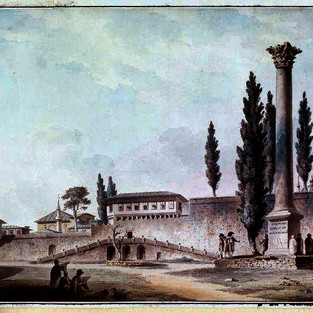Tulip Festival is a Turkish Delight
- Cactusflower

- Apr 10, 2019
- 4 min read
Updated: Jun 14, 2022
When you think of "tulip," what's the first thing that comes to mind? More than likely, your answer is Holland. You know. Holland with tulips, windmills, wooden shoes? The logo or symbol for Holland tourism is a tulip, what could say more?
You might be surprised to learn that the logo or symbol for Turkey tourism is also the tulip, except the Turks call it "lale."
You might be even more surprised to learn that the tulip is not native to Holland. In the 16th century, the Dutch imported the tulip from Ottoman Turkey, where it was a favorite in the royal gardens.
But the tulip wasn't native to Turkey either. Rather, it grows wild on the steppes of central Asia, the Turks' ancestral homeland. The Ottoman Turks cultivated it, and the Dutch, entranced by its beauty, took it to Holland, named it "tulip" from the Turkish "tulbend" or turban, because they thought it looked like one. From Holland, it was widely introduced into Europe and then America.
In today's world of meanings assigned to everything, the tulip symbolizes Perfect Love.
Istanbul Lale (Tulip) Festival
I visited Keukenhof in Holland many years ago, and was awed by the seven million flower bulbs and its variety of 800 different tulips. I never dreamed that I would be in Istanbul during its annual tulip, or lale, festival, when the city plants 30 (yes, 30) million bulbs for the month-long festival in April These bulbs are planted all around the city, in parks and along streets, but are concentrated in several areas, including over a half million planted as a huge "flower carpet" in front of the Sultanahmet (Blue) Mosque. The tulips can also be found in one of the largest parks in Istanbul, Emirgan Woods, as well as the beautiful gardens of the Topkapi Palace, the home of the Ottoman Sultans. These Topkapi gardens are called Gulhane Park (House of Roses--named not so much for roses, but to indicate that it was the Sultan's private garden).
The Tulip Era (Lale Devri)

From about 1718 to 1730, during the latter half of the reign of Sultan Ahmed, Turkish history was called the Tulip Era. It was a transition period marked by a renaissance of sorts, as well as new social standards and activities for the elite. Indeed, it was a time of extravagance, including a great passion for tulips. So great was the passion that the wealthy would import bulbs at great expense, experiment with hybrids, and celebrate the flower's blooming during an elaborate and costly festival that lasted through two successive full moon days in April. The tulips of this time period were called the Istanbul Tulip, with longer, dagger-like petals. It is the tulip seen in stylized art from this period. The Istanbul Tulip was, in effect, cross-bred out of existence.
We chose Gulhane Park for our visit to the Lale Festival because it is adjacent to Topkapi Palace, a place with a centuries-long mystique. Between the 15th and 19th centuries, Topkapi served as the court of the Ottoman Empire. In stories and lore, it was the venue for powerful sultans, beautiful concubines and their eunachs, and scheming courtiers. With is famed Harem (which was really the family quarters though it has been made to be much more) and its vaunted treasury (think Topkapi dagger and the Spoonmaker's Diamond), Topkapi was the seat of power for an empire that touched all of the Mediterranean, parts of Africa, and parts of Europe. Though our visit wasn't a day for the glories of the old Ottoman Empire, it was a day to enjoy a gorgeous Istanbul Tulip Festival.
Ancient Artifacts
Through the backdrop of Topkapi, we saw the fortress-like palace walls, enormous doors and gates.
With a nod to ancient history, (reminder that Istanbul was previously Constantinople and before that, Byzantium), the gardens of Topkapi revealed some even older relics. A walk up a hill, intended simply to cut time and space for us, brought us to ruins of the Orphanage of St. Paul, which was founded by Emperor Justin II (565-578) and served not only orphans, but also elderly people, the blind, and war veterans. Only a few columns and partial walls are left. Continue going up hill, and you will soon face the Column of the Goths. This marble monolith, with breathtaking views of the confluence of the Golden Horn and the Bosphorus, stands almost 50 feet tall and is inscribed as follows:
FORTVNAE REDVCI
OB DEVICTOS GOTHOS
To Fortuna Redux
Owing to the defeat of the Goths
The column was erected to commemorate the Roman victory over the Goths, though which victory is unclear. It could have been Claudius II in 269 (the predominant belief), or even Constantine himself in 331-32. Some believe that atop the column was a statue of the legendary founder of Byzantium, King Byaz. Another ancient historian said that it carried a sculpture of the Greek goddess of fortune and luck, Tyche, since this area of Istanbul used to be the pagan part of the city; Byzantium's acropolis was located here.
Most visitors to this area of Istanbul's Tulip Festival have no idea of the historical backdrop of their close up phone shots of tulips or family photo ops. But that's just fine. What the visitors do know is that a glorious, sunny Spring day and a garden of delightful flowers is a great blessing and gift--the very same that the powerful and mighty who have come before us enjoyed so long ago.





























































Comments